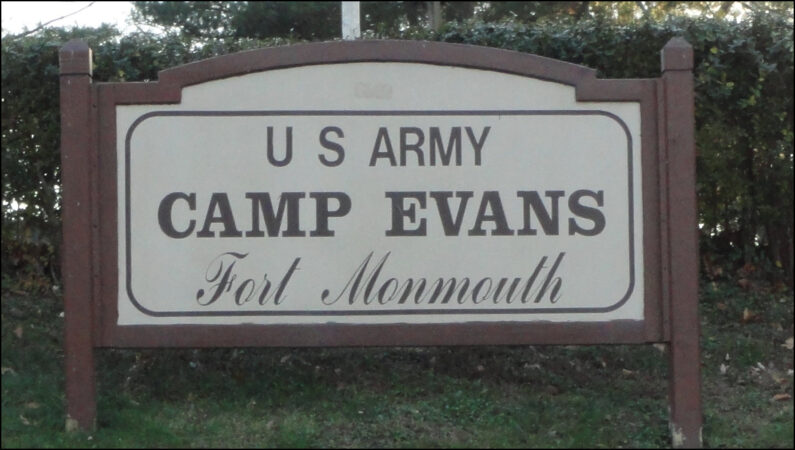On May 27, 1941, U.S. President Franklin Delano Roosevelt declared a state of unlimited national emergency in response to Nazi Germany’s threats of military aggression. The soldiers and civilians of the U.S. Signal Corps at Fort Monmouth had been very busy preparing for this moment.
For the previous 18 months, following FDR’s declaration of a limited state of emergency in 1939, the Signal Corps, like the rest the U.S. military, had immediately responded to the need for expansion, training and accelerated development of new technologies. Additional property was purchased or leased in Monmouth County for ancillary camps to facilitate the rapid expansion, including:
- Camp Coles in Red Bank, north of County Road 520 (Newman Springs Road) and west of Half Mile Road, where the Armed Forces Reserve Center is now located;
- Camp Evans in Wall Township, 2201 Marconi Rd., now home to the InfoAge Science & History Center, a National Historic Landmark, museum and STEM educational center; and,
- Camp Charles Wood in Tinton Falls, south of Tinton Avenue, north of Pine Brook Road, and east of Pearl Harbor Road, on both sides of Hope Road; many of the buildings built during the prewar expansion can still be seen there, and the Suneagles Golf Club is still in operation (and open to the public).
Fort Monmouth would further expand during this time temporarily to include the National Guard Encampment at Sea Girt, which became Camp Edison. In Asbury Park, the Convention Hall, the Marine Grill restaurant, Kingsley Arms Hotel, and other shore hotels were likewise added to accommodate new officer candidates and trainees. (editor’s note: The Kingsley Arms were owned and operated by the family of famed author Norman Kingsley Mailer, for whom the resort was named.)
Many of America’s most important weapons systems were developed or refined at Fort Monmouth during this period, and then manufactured according to U.S. Army Signal Corps specifications. While many different technologies and systems were part of the Signal Corps effort, those that are considered by many to have had the biggest impact on World War II were in the related fields of radio and radar.
The Torch of Radio Research Passes from Marconi to the Signal Corps in Wartime
On September 30, 1899, Guglielmo Marconi successfully demonstrated wireless telegraphy from the Twin Lights in Highlands, as well as at locations on Sandy Hook, West Belmar, and other areas within Monmouth County. Over the ensuing decades research into radio continued, with scientists around the world seeking to fulfill its promise.
In 1939, following FDR’s declaration of a state of limited emergency, Marconi’s Monmouth County locations and their equipment were taken over by the Signal Corps to focus on military applications. Engineers at Fort Monmouth produced a series of new and improved radios of various types; each bore a stamp that read “SCR” standing for “Signal Corps Radio” along with the number of that particular type of radio.
Signal Corps radios were devised for aircraft, for tanks and artillery units, but possibly the most well-known was the “Walkie-Talkie,” also known as SCR-300, first distributed to military units in 1938 and continually improved over time. This backpack unit revolutionized field communications for infantry and other ground forces.
In 1938, Major General Roger B. Colton, head of the Signal Corps Laboratories, made the historic decision to employ frequency modulation (FM) radio systems over amplitude modulation (AM). While FM was considered to be a more limited system, it offered significantly greater clarity and signal quality. Under Colton’s leadership, the Signal Corps worked to refine and expand the range of FM in SCR systems, which historians consider to be among the technology factors that helped the Allies win the war.
SOURCES:
Radosh, Ronald & Milton, Joyce. (1983). The Rosenberg File: A Search for the Truth. Holt, Rinehart and Winston, New York, N.Y.
Rejan, Wendy A. (2008). A History of Army Communications and Electronics at Fort Monmouth, New Jersey 1917-2007. Office of the Deputy Chief of Staff for Operations and Plans, U.S. Army CECOM Life Cycle Management Command, Fort Monmouth, N.J. U.S. Government Printing Office, available: bookstore.gpo.gov.
Usdin, Steven T. (2005). Engineering Communism: How Two Americans Spied for Stalin and Founded the Soviet Silicon Valley. Yale University Press, New Haven, Conn.
Usdin, Steven T. (2007). Tracking Julius Rosenberg’s Lesser Known Associates: Famous Espionage Cases. Central Intelligence Agency Library, April 15, 2007. Updated June 26, 2008. Available: https://www.cia.gov/library/center-for-the-study-of-intelligence/csi-publications/csi-studies/studies/vol49no3/html_files/Rosenberg_2.htm


I got grafted Sept 28,1959 – I enrolled in the
Photography school (10 weeks) at Fort
Monmouth- April 1,1960 I developed the
first 4 photo taken from outter space called
T.I.R.O.S. sent to President Eisenhower !@
Hi Mr. Abruzzini, thanks for sharing this, I would really like to talk to you about the FM Photography School, I’d really like to learn more about it and what people like you who went through that program ended up doing. Did you know Marilyn Levy? You can reach me directly at editor@monmouthtimeline.org, LMK if you can spare some time! Thanks again. – John Barrows, Editor, Monmouth Timeline